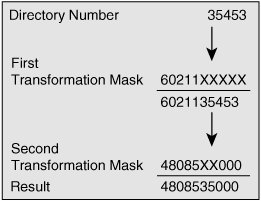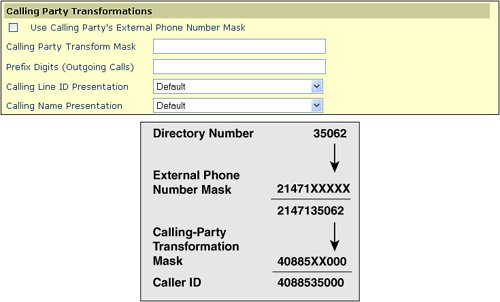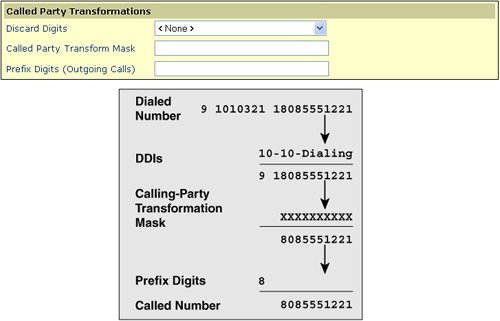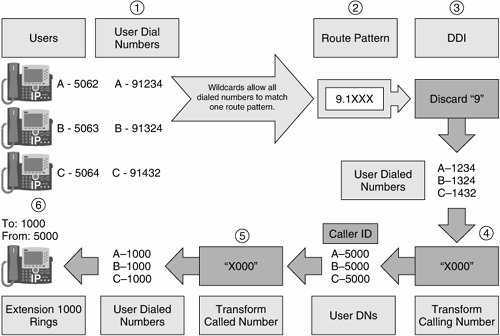Transformation Masks
Dialing transformations allow the call-routing component to modify either the calling number or the dialed digits of a call. Transformations that modify the calling number are calling-party transformations; transformations that modify the dialed digits are called-party transformations.
Calling-party transformation settings allow you to manipulate the appearance of the calling-party number for outgoing calls. A common application of a calling-party transformation is to use the company external phone number of a calling station in place of the directory number (DN) for outgoing calls. The calling-party number is used for Calling Line Identification (CLID). During an outgoing call, the CLID is passed to each PBX, CO, and interexchange carrier (IXC) as the call progresses. The CLID is also delivered to the calling party when the call is completed.
Note
Caller ID is also referred to as Automatic Number Identification (ANI).
Called-party transformation settings allow you to manipulate the dialed digits, or called-party number, for outgoing calls. Examples of manipulating called numbers include appending or removing prefix digits (outgoing calls), appending area codes to calls that are dialed as seven-digit numbers, appending area codes and office codes to interoffice calls that are dialed as four- or five-digit extensions, and suppressing carrier access codes for outgoing calls.
When configuring calling- or called-party transformations, a transformation mask operation allows the suppression of leading digits, the change of some digits while leaving others unmodified, and the insertion of leading digits. A transformation mask requires two pieces of information: the number that you want to mask and the mask itself.
In the transformation mask operation, Cisco CallManager aligns the number with the mask so that the last character of the mask aligns with the last digit of the number. Cisco CallManager uses the corresponding digit of the number wherever the mask contains an X. If the number is longer than the mask, the mask removes the leading digits. Figure 11-7 demonstrates the transformation mask logic.
Figure 11-7. Transformation Mask Logic

As you can see from Figure 11-7, the initial number (which could be dialed or caller ID information, depending on the type of transformation mask you choose) passes through the first transformation mask. By right-justifying the digits, CallManager passes the number 35453 through the first transformation mask. The digits match to the right-justified X wildcards, causing it to pass through. CallManager prepends the additional digits to the left of the wildcards. As it passes through the second transformation mask, the numbers are again right-justified. This time, only the "35" digits pass through the X wildcards; CallManager replaces the rest of the string with the hard-coded digits to the left and right of the X wildcards.
Calling-Party Transformations
The example in Figure 11-8 shows the applicable settings for calling-party transformations and the order in which Cisco CallManager processes those instructions.
Figure 11-8. Calling-Party Transformations

You can configure three types of calling-party transformations in the call-routing component and on route lists:
- Use the external phone number mask, which instructs the call-routing component to use the external phone number of a calling station rather than its DN or the caller ID information. Without the external phone number mask, the calling number might appear as an extension number to the PSTN rather than a fully routable PSTN phone number. You can apply the external phone number mask on a line-by-line basis through the DN configuration screen on the device.
- The calling-party transformation mask allows the suppression of leading digits, leaves other digits unmodified, and inserts leading digits. As shown in Figure 11-8, the post-external phone number mask caller ID information is 2147135062. This passes through the calling-party transformation mask of 40885XX0000, which allows only the numbers "35" to pass through the XX wildcards. The resulting caller ID information is 4088535000.
- Prefix digits allow the prepending of specified digits to the calling number.
Cisco CallManager applies the transformations in the order that is presented in the example.
Tip
Remember, the calling-party transformations transform caller ID information (the number of the person who is calling).
Called-Party Transformations
The example in Figure 11-9 shows the applicable settings for called-party transformations and the order in which Cisco CallManager processes those instructions.
Figure 11-9. Called-Party Transformations

You can configure the following three types of called-party transformations in the call-routing component and on route lists:
- DDIs allow the discarding of digits in the dialed number. Such instructions are critical for implementing toll-bypass solutions. This need arises when Cisco CallManager must convert the long-distance number that the calling party has dialed into a local number. This number allows Cisco CallManager to pass the digits to the PSTN. You can also use DDIs to discard PSTN access codes, such as 9. Figure 11-9 demonstrates the removal of the 10-10-Dialing portions of the call to eliminate other long-distance carriers a user might choose to use.
- The called-party transformation allows the suppression of leading digits, changes the existing digits while leaving others unmodified, and inserts leading digits. Figure 11-9 illustrates the use of a called-party transformation mask consisting of ten "X" wildcards. This has the effect of stripping any preceding digit beyond the ten wildcards (in this case, CallManager strips the 9 and the 1). This might be necessary when configuring toll-bypass on the CallManager. For example, you might have a location that can access the 808 area code without incurring toll charges. You can configure the Cisco CallManager to route the call across the IP WAN then out a LEC.
- Prefix digits allow the prepending of one or more digits to the called number. Figure 11-9 illustrates prefixing an 8 to the front of the original dialed number. This might be required by a PBX at a remote site. For example, the call is transformed using the called-party transformation mask, then prefixed with an 8 and routed across the IP WAN. When the PBX at the remote site received the string, it recognizes the 8 as an outside access code and routes the call to the PSTN LEC.
Cisco CallManager applies the transformation in the order that is presented in the example.
Note
You could accomplish the same result shown in Figure 11-9 by simply applying a called-party transformation mask of 8XXXXXXXXXX. This is a more efficient method; the called-party transformations shown are used to illustrate the various transformations and the order in which the CallManager applies them.
Tip
Remember, the called-party transformations transform dialed-number information (the number that a user called).
Configuring Calling- and Called-Party Transformation Masks
You can apply calling- and called-party transformations at the route pattern, route list, or translation pattern configuration windows. The calling-party transformation setting that is used in route lists applies to the individual route groups that make up the list rather than to the entire route list. The calling-party transformation settings that are assigned to the route groups in a route list override any calling-party transformation settings that are assigned to a route pattern that is associated with that route list.
Because you can be more specific, network administrators usually apply transformation masks at the route list level. In this way, you can assign a different transformation mask for each route group in the route list. Transformation masks configured at the route list level have priority over those configured at the route pattern level because they are processed last. If you have configured a transformation at the route pattern level, it becomes more of a "global" translation, that is, as soon as the pattern is matched, the transformation takes effect. As the route pattern sends the call to the route list and the prioritized route group is chosen, the transformations relating to that specific route group apply second, transforming the already transformed number from the route pattern into whatever you have defined.
For example, in the network illustrated in Figure 11-10, a network administrator has two route groups created: the PSTN route group and the IP WAN route group. Both of these route groups contain multiple gateways that connect to their respective networks. When Cisco CallManager forwards a call to a gateway in the PSTN route group, the network administrator applies a mask that transforms the number into an E.164-compliant phone number. However, when Cisco CallManager uses a gateway from the IP WAN route group, Cisco CallManager leaves the number as a four-digit extension.
Figure 11-10. Transformation Network Design

Transformation Example
Figure 11-11 summarizes how transformations to the called-party (dialed digits) and to the calling-party numbers are made within Cisco CallManager. In Figure 11-11, a user dials a number to which Cisco CallManager first applies a calling-party transformation ("calling party" refers to the person who originated the call). This action changes the caller ID number that is displayed on the destination phone. Cisco CallManager then applies a called-party transformation to change the number that is dialed.
Figure 11-11. Called-Party Transformations

The two transformations are explained in the figure and, for user A specifically, in the following steps:
|
1. |
User A has a DN of 5062. This user dials DN 91234. |
|
2. |
The dialed number matches the route pattern 9.1xxx. |
|
3. |
The DDIs contain instructions to discard the 9. The dialed number is now 1234. |
|
4. |
The calling number 5062 now passes through the calling-number transformation mask, which contains instructions to change the last three digits of the calling party number to 000. The new calling number is 5000. |
|
5. |
Cisco CallManager then passes the called number 1234 through the called-number transformation mask X000, which changes the dialed number to 1000. |
|
6. |
The result is a calling-party number of 5000 and a called-party number of 1000. |
Translation Patterns |
Part I: Cisco CallManager Fundamentals
Introduction to Cisco Unified Communications and Cisco Unified CallManager
Cisco Unified CallManager Clustering and Deployment Options
- Cisco Unified CallManager Clustering and Deployment Options
- The Two Sides of the Cisco Unified CallManager Cluster
- Cluster Redundancy Designs
- Call-Processing Deployment Models
- Summary
- Review Questions
Cisco Unified CallManager Installation and Upgrades
- Cisco Unified CallManager Installation and Upgrades
- Cisco Unified CallManager 4.x Clean Installation Process
- Upgrading Prior Cisco Unified CallManager Versions
- Summary
- Review Questions
Part II: IPT Devices and Users
Cisco IP Phones and Other User Devices
Configuring Cisco Unified CallManager to Support IP Phones
- Configuring Cisco Unified CallManager to Support IP Phones
- Configuring Intracluster IP Phone Communication
- IP Phone Configuration
- Case Study: Device Pool Design
- Summary
- Review Questions
Cisco IP Telephony Users
- Cisco IP Telephony Users
- Cisco CallManager User Database
- Cisco CallManager User Configuration
- User Logon and Device Configuration
- Summary
- Review Questions
Cisco Bulk Administration Tool
- Cisco Bulk Administration Tool
- The Cisco Bulk Administration Tool
- Using the Tool for Auto-Registered Phone Support
- Summary
- Review Questions
Part III: IPT Network Integration and Route Plan
Cisco Catalyst Switches
- Cisco Catalyst Switches
- Catalyst Switch Role in IP Telephony
- Powering the Cisco IP Phone
- Data and Voice VLANs
- Configuring Class of Service
- Summary
- Review Questions
Configuring Cisco Gateways and Trunks
- Configuring Cisco Gateways and Trunks
- Cisco Gateway Concepts
- Configuring Access Gateways
- Cisco Trunk Concepts
- Configuring Intercluster Trunks
- SIP and Cisco CallManager
- Summary
- Review Questions
Cisco Unified CallManager Route Plan Basics
- Cisco Unified CallManager Route Plan Basics
- External Call Routing
- Route Plan Configuration Process
- Summary
- Review Questions
Cisco Unified CallManager Advanced Route Plans
- Cisco Unified CallManager Advanced Route Plans
- Route Filters
- Discard Digit Instructions
- Transformation Masks
- Translation Patterns
- Route Plan Report
- Summary
- Review Questions
Configuring Hunt Groups and Call Coverage
- Configuring Hunt Groups and Call Coverage
- Call Distribution Components
- Configuring Line Groups, Hunt Lists, and Hunt Pilots
- Summary
- Review Questions
Implementing Telephony Call Restrictions and Control
- Implementing Telephony Call Restrictions and Control
- Class of Service Overview
- Partitions and Calling Search Spaces Overview
- Time-of-Day Routing Overview
- Configuring Time-of-Day Routing
- Time-of-Day Routing Usage Scenario
- Summary
- Review Questions
Implementing Multiple-Site Deployments
- Implementing Multiple-Site Deployments
- Call Admission Control
- Survivable Remote Site Telephony
- Summary
- Review Questions
Part IV: VoIP Features
Media Resources
- Media Resources
- Introduction to Media Resources
- Conference Bridge Resources
- Media Termination Point Resources
- Annunciator Resources
- Transcoder Resources
- Music on Hold Resources
- Media Resource Management
- Summary
- Review Questions
Configuring User Features, Part 1
- Configuring User Features, Part 1
- Basic IP Phone Features
- Softkey Templates
- Enhanced IP Phone Features
- Barge and Privacy
- IP Phone Services
- Summary
- Review Questions
Configuring User Features, Part 2
- Configuring User Features, Part 2
- Cisco CallManager Extension Mobility
- Client Matter Codes and Forced Authentication Codes
- Call Display Restrictions
- Malicious Call Identification
- Multilevel Precedence and Preemption
- Summary
- Review Questions
Configuring Cisco Unified CallManager Attendant Console
- Configuring Cisco Unified CallManager Attendant Console
- Introduction to Cisco CallManager Attendant Console
- Call Routing and Call Queuing
- Server and Administration Configuration
- Cisco Attendant Console Features
- Summary
- Review Questions
Configuring Cisco IP Manager Assistant
- Configuring Cisco IP Manager Assistant
- Cisco IP Manager Assistant Overview
- Cisco IP Manager Assistant Architecture
- Configuring Cisco IPMA for Shared-Line Support
- Summary
- Review Questions
Part V: IPT Security
Securing the Windows Operating System
- Securing the Windows Operating System
- Threats Targeting the Operating System
- Security and Hot Fix Policy
- Operating System Hardening
- Antivirus Protection
- Cisco Security Agent
- Administrator Password Policy
- Common Windows Exploits
- Security Taboos
- Summary
- Review Questions
Securing Cisco Unified CallManager Administration
- Securing Cisco Unified CallManager Administration
- Threats Targeting Remote Administration
- Securing CallManager Communications Using HTTPS
- Multilevel Administration
- Summary
- Review Questions
Preventing Toll Fraud
- Preventing Toll Fraud
- Toll Fraud Exploits
- Preventing Call Forward and Voice-Mail Toll Fraud Using Calling Search Spaces
- Blocking Commonly Exploited Area Codes
- Using Time-of-Day Routing
- Using FAC and CMC
- Restricting External Transfers
- Dropping Conference Calls
- Summary
- Review Questions
Hardening the IP Phone
Understanding Cryptographic Fundamentals
- Understanding Cryptographic Fundamentals
- What Is Cryptography?
- Symmetric Encryption
- Asymmetric Encryption
- Hash Functions
- Digital Signatures
- Summary
- Review Questions
Understanding the Public Key Infrastructure
- Understanding the Public Key Infrastructure
- The Need for a PKI
- PKI as a Trusted Third-Party Protocol
- PKI Entities
- PKI Enrollment
- PKI Revocation and Key Storage
- PKI Example
- Summary
- Review Questions
Understanding Cisco IP Telephony Authentication and Encryption Fundamentals
- Understanding Cisco IP Telephony Authentication and Encryption Fundamentals
- Threats Targeting the IP Telephony System
- How CallManager Protects Against Threats
- PKI Topologies in Cisco IP Telephony
- PKI Enrollment in Cisco IP Telephony
- Keys and Certificate Storage in Cisco IP Telephony
- Authentication and Integrity
- Encryption
- Summary
- Review Questions
Configuring Cisco IP Telephony Authentication and Encryption
- Configuring Cisco IP Telephony Authentication and Encryption
- Authentication and Encryption Configuration Overview
- Enabling Services Required for Security
- Using the CTL Client
- Working with Locally Significant Certificates
- Configuring the Device Security Mode
- Negotiating Device Security Mode
- Generating a CAPF Report
- Summary
- Review Questions
Part VI: IP Video
Introducing IP Video Telephony
- Introducing IP Video Telephony
- IP Video Telephony Solution Components
- Video Call Concepts
- Video Protocols Supported in Cisco CallManager
- Bandwidth Management
- Call Admission Control Within a Cluster
- Call Admission Control Between Clusters
- Summary
- Review Questions
Configuring Cisco VT Advantage
- Configuring Cisco VT Advantage
- Cisco VT Advantage Overview
- How Calls Work with Cisco VT Advantage
- Configuring Cisco CallManager for Video
- Configuring Cisco IP Phones for Cisco VT Advantage
- Installing Cisco VT Advantage on a Client
- Summary
- Review Questions
Part VII: IPT Management
Introducing Database Tools and Cisco Unified CallManager Serviceability
- Introducing Database Tools and Cisco Unified CallManager Serviceability
- Database Management Tools
- Cisco CallManager Serviceability Overview
- Tools Overview
- Summary
- Review Questions
Monitoring Performance
- Monitoring Performance
- Performance Counters
- Microsoft Event Viewer
- Microsoft Performance Monitor
- Real-Time Monitoring Tool Overview
- Summary
- Review Questions
Configuring Alarms and Traces
- Configuring Alarms and Traces
- Alarm Overview
- Alarm Configuration
- Trace Configuration
- Trace Analysis
- Trace Collection
- Bulk Trace Analysis
- Additional Trace Tools
- Summary
- Review Questions
Configuring CAR
- Configuring CAR
- CAR Overview
- CAR Configuration
- Report Scheduling
- System Database Configuration
- User Report Configuration
- Summary
- Review Questions
Using Additional Management and Monitoring Tools
- Using Additional Management and Monitoring Tools
- Remote Management Tools
- Dependency Records
- Password Changer Tool
- Cisco Dialed Number Analyzer
- Quality Report Tool
- Summary
- Review Questions
Part VIII: Appendix
Appendix A. Answers to Review Questions
Index
EAN: 2147483647
Pages: 329
